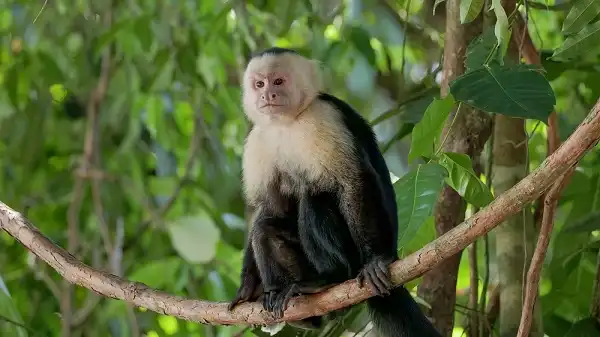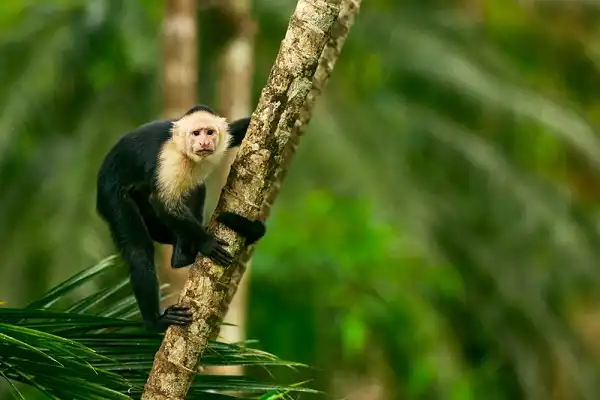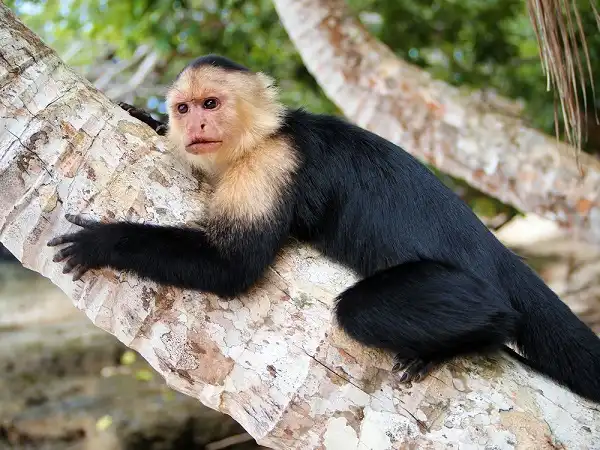Welcome to my blog! Here I will be discussing the white-faced capuchin, a species of primate that is native to Central and South America. These animals are fascinating creatures, and I hope to provide some interesting information about them for my readers.

White Faced Capuchin Description
White-faced capuchins, also known as Cebus capucinus, are a species of New World monkeys that inhabit a variety of habitats ranging from tropical forests to dry, open grasslands in Central and South America. They have dense black fur with a distinctive white face and throat and a creamy brown crown. Males typically weigh around 6.5 lbs, while females reach 4 lbs. Capuchins are arboreal animals and spend most of their time high up in the trees, although they can descend to the ground if necessary. Capuchins are highly social primates and live in large groups of up to 40 individuals. Each group is organized around an alpha male that is responsible for protecting the group from predators and ensuring food resources are shared among members. Members of the group interact with one another constantly through vocalization, physical contact, grooming, facial expressions, and body posture. The group will also travel together during their daily activities such as foraging for food which can include nuts, fruits, insects, small birds, and lizards.
White Faced Capuchin Habitat
White-faced Capuchins are found in Central and South America, inhabiting both tropical forests and dry open grasslands. They have adapted to a wide range of habitats, from humid lowland evergreen forests to deciduous dry forests, as well as semi-arid areas with sparse vegetation such as cactus and shrubs. They live at elevations up to 9,000 feet (2,700 m) and have even been reported living in urban environments. Capuchins prefer to live in groups that can range from 10 to 40 individuals, with one dominant male leading the group. Groups typically stay together for up to 2 years before splitting off into smaller subgroups or dispersing elsewhere. Females usually remain in their natal group for life while males disperse after reaching sexual maturity at about 4 years of age. As arboreal primates, white-faced capuchins inhabit and travel through the trees using their long arms and prehensile tails for support. They often sleep high up in the canopy where it is protected from encroaching predators and the elements. During daylight hours they spend most of their time foraging for food and traveling through the trees in search of new resources.
White Faced Capuchin Diet
White-faced capuchins are omnivorous creatures that feed primarily on fruits, nuts, seeds, insects, and other small animals such as lizards and birds. They can also ingest leaves, buds, and flowers when the fruit is scarce. In some areas, they have been observed supplementing their diet with the eggs of ground-dwelling birds. The white-faced capuchin’s daily foraging activities usually revolve around locating individual food items such as fruits or nuts scattered throughout the trees or in the understory vegetation – so they must be adept at using their senses (sight, smell, and hearing) to locate these resources.
As well as utilizing their sharp claws to open hard shells they may also use tools such as stones or sticks to crack open harder objects in order to access the nutritional contents inside. Capuchins display a great deal of flexibility in the types of foods they consume depending on availability; this means they can cope with seasonal variations in resource availability by switching diets to whatever is most abundant at that particular time. For instance, if there is an abundance of ripe fruit available then they will mostly feed on this but if not then it’s likely that insects or small animals will be consumed instead.

White Faced Capuchin Size
White Faced Capuchins are generally small primates, typically ranging between 11 and 22 inches in length with a tail length of up to 30 inches. The white-faced capuchin is an arboreal species which means that they spend most of their time living in trees – so it’s not surprising that they possess several adaptations which allow them to easily move through the canopy layer of the forest. For example, they have relatively long arms and legs giving them more reach when climbing branches or leaping from one tree to another. They also possess prehensile tails which can act as an extra limb allowing them to grab onto branches or other objects as they pass by – this helps make traversing through the treetops much easier!
White Faced Capuchin Lifespan
White Faced Capuchins have an average lifespan of 15-20 years in the wild, however, captivity can extend this to upwards of 40 years. This is due to the fact that captive primates are able to benefit from improved nutrition, better medical care, and other environmental factors which help increase their longevity. Wild White Faced Capuchins may experience a variety of threats throughout their lifetime ranging from predation by larger animals such as birds and jaguars, to competition for resources with conspecifics or even human activity. In addition, these primates are also known to face numerous health issues related to food shortages, climate change, or disease. However given the right conditions these animals can prove hardy and live well into adulthood – though it’s not unusual for them to suffer from age-related illnesses such as arthritis or cataracts in old age.
White Faced Capuchin Behavior
White Faced Capuchins are highly intelligent primates with a complex range of behaviors that sets them apart from other species in the region. They live in large groups of up to 40 individuals and display strong social bonds within these groups, with each animal having their own unique personality and set of behaviors. One example of this is their use of tools – White Faced Capuchins have been observed using sticks, stones, or even fruits to retrieve ants or termites from their mounds – often stripping the branches they find of leaves before doing so. In addition, they have also been seen manipulating objects such as stones and nuts in order to crack them open to get at the food inside.
This behavior shows that they are able to think logically and problem-solve in order to get what they want – something often seen in more advanced species such as humans! In terms of communication, White Faced Capuchins use a variety of vocalizations including clicks, grunts, and screams to communicate different messages – these can be used for anything from warning other capuchins about predators approaching, or showing aggression towards conspecifics who are intruding on their territory. In addition, they also utilize touch and facial expressions as part of their communication repertoire – this can include grimacing when angry or baring teeth when threatened by another individual.

White Faced Capuchin Speed
White Faced Capuchins are known for their agility and quickness – something which has been observed by researchers in the wild. They are able to climb through trees at lightning speed and can even perform somersaults mid-air! These primates are also quite proficient on the ground, using their powerful legs to propel them forward with amazing speed when necessary. They have been known to cover distances of up to 10ft in under a second, making them one of the fastest primates in Central and South America. In terms of agility, White Faced Capuchins possess an impressive repertoire of movements that enable them to deftly maneuver around obstacles with ease. They make use of both their arms and legs when climbing through the trees, often swinging from branch to branch with remarkable grace and control. This is made possible through their strong wrists and ankles which act as shock absorbers when they land, allowing them to absorb impact while still maintaining their balance.
White Faced Capuchin Hunting
White Faced Capuchins are expert hunters who employ a variety of strategies to acquire food. They hunt both on the ground and in the trees, often using tools to enlarge their catchment area and increase their chances of success. One of their methods involves using a stone or other hard object to break open nuts and other hard-shelled fruit to get at the inner edible parts. This technique has been observed in the wild, with White Faced Capuchins holding the stones in one hand while using its other hand to bash it against the nuts – sometimes even hurling it at them from a distance! In addition to gathering plant material, White Faced Capuchins are also known for hunting small vertebrates including lizards, snakes, birds, insects, and fish. They will often form groups to hunt larger animals such as deer or monkeys – using their agility and speed to surround their prey before attacking it simultaneously. These primates also make use of tools when hunting – something which is quite uncommon among non-human primates. For instance, they have been observed fashioning sticks into spears by sharpening one end into a point – this enables them to reach deep holes where they can spear small animals like frogs or rodents that may be hiding there.

Conclusion
White Faced Capuchins are one of the most fascinating primates in Central and South America. They possess incredible agility, speed, and coordination – making them incredibly efficient climbers who can move across obstacles with remarkable grace. Furthermore, these primates also make use of tools when hunting which further enhances their success rate – something that is quite uncommon among non-human primates. All these traits combined make White Faced Capuchins one of the most successful species in the wild!
Frequently Asked Question

